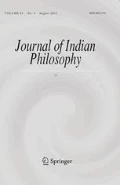Abstract
How is it possible to say that truth can be of one kind at the conventional level and totally different in the ultimate plane? As Matilal (1971, p. 154) points out, Kumārila (ca. 600–650), a Mīmāṃsaka philosopher, claims that the Buddhist doctrine of two truths is “a kind of philosophical ‘double-talk’.” It is Prajñākaragupta (ca. 750–810), a Buddhist logician, who tries to give a direct answer to this question posed by Kumārila from the Buddhist side. He argues that even a Mīmāṃsaka cannot demonstrate the validity (prāmāṇya) of the Veda without accepting two truth levels. His point is this. Consider the proposition to be proved: the Veda is valid. If the Veda is already known as valid, then it is useless to prove this proposition. But if it is already known as invalid, then it is impossible to prove this proposition. Therefore in the argument to prove the proposition, the Veda is not to be regarded either as valid or as invalid. This means that at the first stage of the argument one has the concept of the Veda as neutral in validity. However, as soon as one acquires the knowledge of the Veda as valid through the argument, one has to repudiate such a conception of the Veda. The acceptance of the Veda as neutral in validity is to the acceptance of the Veda as valid as the conventional truth is to the ultimate truth.
Similar content being viewed by others
Abbreviations
- M:
-
Manuscript B of Pramāṇavārttikālaṃkāra in Watanabe (1998).
- MMK:
-
Mūlamadhyamakakārikā of Nāgārjuna (1977).
- NBhū:
-
Nyāyabhūṣaṇa of Bhāsarvajña (1968).
- PVA:
-
Pramāṇavārttikālaṃkāra of Prajñākaragupta (1953).
- ŚV:
-
Ślokavārttika of Kumārila (1898–1899).
- T:
-
Tibetan translation of Pramāṇavārttikālaṃkāra. Derge edition (D) 4221; Peking edition (P) 5719.
References
Akahane R. (2003) On the value of “avicāraikaramaṇīya” as an indicator to establish the date. Journal of the Nanto Society for Buddhist Studies 83: 33–59 (In Japanese)
Bhāsarvajña (1968). Nyāyabhūṣaṇam. Svāmī Yogīndrānanda ed. Ṣaḍdarśanaprakāśana Granthamālā 1. Varanasi: Śaddarśan Prakāśan Pratiṣṭhān.
D = sDe dge Tibetan Tripiṭaka bsTan ’gyur—preserved at the Faculty of Letters, University of Tokyo. J. Takasaki, Z. Yamaguchi, & Y. Ejima (Eds.), Tokyo, 1981–1984.
Hattori, M. (1982). The dreaming simile inVijñānavāda treatises. In L.A.Hercus et al. (Eds.) Indological and Buddhist studies: Volume in honour of Professor J. W. de Jong on his sixtieth birthday (pp. 235–242). Canberra: Faculty of Asian Studies.
Ichigo M. (1985) Madhyamakālaṃkāra. Kyoto, Buneido
Inami, M. (2004). Prajñākaragupta, on Nondual cognition. In: Studies on Indian philosophy and Buddhist thoughts: Volume in Honor of Professer Esho Mikogami (pp. 387–456). Kyoto: Nagatabunshodo (in Japanese).
Jayanta. Tshad ma rnam ’grel gyi rgyan gyi ’grel bshad. (*Pramāṇavārttikālaṃkāraṭīkā). D4222; P5720.
Kumārila. (1898–1899). In R. Tallanga (Ed.), The Mīmāṃsā Ślokavārttika of Kumārila Bhaṭṭa with the Commentary called Nyāyaratnākara by Pārthasārathimiśra. Chowkhamba Sanskrit Series No. 3, Varanasi.
Matilal B.K. (1971) Epistemology, logic, and grammar in Indian philosophical analysis. Mouton, The Hague
Nāgārjuna. (1977). In J. W. de Jong (Ed.), Nāgārjuna, Mūlamadhyamakakārikāhḥ. Chennai: The Adyar Library and Research Centre.
P = The Tibetan Tripiṭaka, Peking edition. D. T. Suzuki (Ed.), Tokyo-Kyoto, 1955–1961.
Pārthasārathimiśra. (1898–1899). See Kumārila (1898–1899).
Prajñākaragupta (1953). In R. Sāṅkṛ tyāyana (Ed.), Pramāṇavārttikabhāṣyam or Vārttikālaṅkārahḥ of Prajñākaragupta. Tibetan Sanskrit Works Series No. 1. Patna: Kashi Prasad Jayaswal Research Institute.
Sucaritamiśra. (1913/1990). In K. Sāmbaśiva Sāstrī (Ed.), Mīmāṃsā Ślokavārttika with the Commentary Kāśikā of Sucaritamiśra. Trivandrum Sanskrit Series Nos. 23, 29 and 31. Trivandrum: CBH Pub- lication (Originally published in 1913).
Watanabe, S. (Ed.). (1998). Sanskrit manuscripts of Prajñākaragupta’s Pramāṇavārttikabhāṣyam (Fac-simile ed.). Patna/Narita: Bihar Research Society/Naritasan Institute for Buddhist Studies.
Yamāri. Tshad ma rnam ’grel gyi rgyan gyi ’grel bshad shin tu yongs su dag pa zhes bya ba.(*Pramāṇavārttikālaṃkāraṭīkā supariśuddhi nāma). D4226; P5723.
Author information
Authors and Affiliations
Corresponding author
Rights and permissions
About this article
Cite this article
Kobayashi, H. Prajñākaragupta on the Two Truths and Argumentation. J Indian Philos 39, 427–439 (2011). https://doi.org/10.1007/s10781-011-9140-1
Published:
Issue Date:
DOI: https://doi.org/10.1007/s10781-011-9140-1




